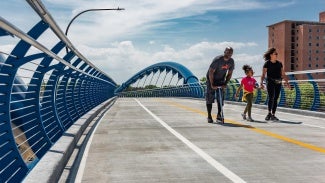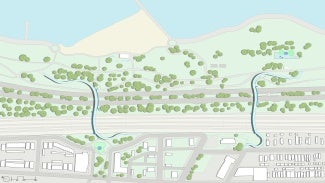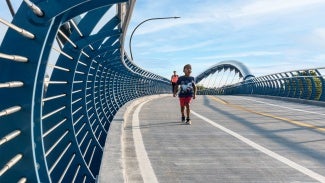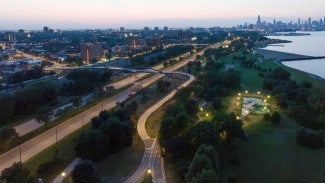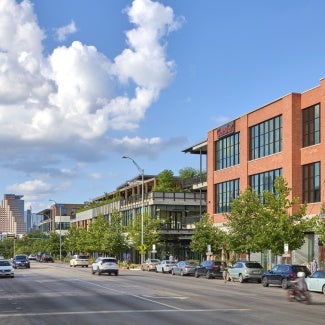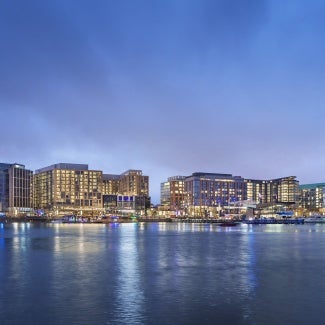41st and 43rd Street Pedestrian Bridges, Chicago
The award-winning regional and urban design for 41st and 43rd Street Pedestrian Bridges, Chicago, provides a unique and memorable experience for their users.

Project highlights
- Architects: Cordogan Clark & Associates
- Owner: Chicago Department of Transportation
- Location: Chicago
Arising from Bridging the Drive, an international design competition launched by the city of Chicago, this project has created two signature pedestrian bridges that link the city’s Bronzeville neighborhood with the Lake Michigan waterfront. They are the second and third of five planned bridge projects, all aimed at memorably connecting residents and visitors with the lake
In the early 2000s, then-Mayor Richard M. Daley was impressed by the pedestrian-oriented infrastructure he experienced in Europe and sought to achieve something similar in his city. However, due to the complexities related to public infrastructure approvals, elections, and overall funding, it took nearly 15 years to begin construction of the 41st Street Bridge and nearly 20 year before the second bridge was completed.
Before the two bridges were built, residents were forced to travel a half mile to the nearest span, a narrow and corroded footbridge spanning nearby railroad tracks. The new bridges, designed to accommodate pedestrians, cyclists, people with disabilities, and emergency services, link recently redeveloped neighborhoods on the west with a lakefront trail and 41st Street Beach. Both include ramps and stairs on either end, and their overall design minimizes their footprints in the adjacent parks while still bolstering accessibility.
Drawing on the unspoiled openness of Chicago’s lakefront, largely due to landscape architect Frederick Law Olmsted’s vision and the city’s long tradition of structural rationalism, the team made the bridges’ architecture subordinate to the experience. With their horizontal and vertical curves, the bridges mend the divide between the city and nature by creating graceful but dynamic urban promenades. The arches parallel the curves of the decks, ramps, and railings as they gently glide to rest at the end of their spans where they merge with the ramps that taper into the landscape.
As an additional component of the project, the team landscaped the parks adjacent to the bridges. A playground received new equipment and cushioned ground surfacing, while walkways, which had been straightened over time, were curved once again. The landscaping for each bridge incorporates stormwater management bioretention areas where runoff drains through a matrix of conditioned soil, mulch, plants, and a filtering substrate that breaks down or assimilates pollutants.
Since their completion, the bridges have quickly become a popular and convenient way for Bronzeville residents to travel back and forth to the waterfront. They’ve also proven to be one of the city’s most popular destinations, where lakefront promenades, bike paths, and places to gather and socialize await all social and economic groups.
Project team & jury
Architect: Cordogan, Clark & Associates, Inc.
Landscape Architect: Terry Guen Design Associates
Lead Civil and Structural Design and Engineering Firm: AECOM
Construction Engineering Firm: TranSystems
Engineer — Structural: AECOM
Engineer — Structural: HBM Engineering Group
Engineer — Structural: Cordogan, Clark & Associates, Inc.
Engineer — Electrical: Singh & Associates
Engineer — Geotechnical: Ground Engineering Consultants
Engineer — Environmental: Kowalenko Consulting Group
General Contractor: F.H. Paschen
Neil Kittredge, AIA, Chair, Beyer Blinder Belle, New York.
Mide Akinsade, AIA, Perkins & Will, Houston
Kim Reddin, AIA, FLAD, Madison, Wis.
Sheba Ross, HKS Architects, Atlanta
Vince Tam, AIA, HNTB, Dallas
A Regional & Urban Design Award recognizes the best in urban design, regional and city planning, and community development.
Five projects showcase 2024's best planning projects that account for the entire built environment, local culture, and available resources.

